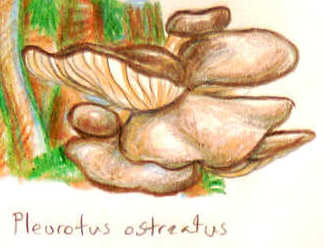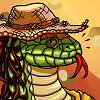Sign In
CloseMushroom Guidesheet #1--King Stropharia or Winecap by SpiderMilkshake (critique requested)
Stropharia rugosoannulata, known by many as the King Stropharia or the Winecap Mushroom. This is a choice edible mushroom and one of the gilled fungi for the intermediate 'shroom forager for its relative ease of identification.
Key traits:
-The annulus, or stem ring, is ruffled or crimped in such a way that it looks almost like a cogwheel has been stuck on the stem.
-Young mushrooms are a wine-red color (this color fades with maturity and age, meaning it can be a reddish brown or a pale brown). There is a whitish variant!
-The gills are attached to the stem and are a gray-violet color which gets darker with age. They are typically crowded to semi-distant.
-Almost always grows from mulched areas, woodchips, and other wood debris (not from logs or trunks)
-Spore print color is always a purple-brown color. This can be very dark so as to be almost black.
*Note that the King Stropharia will never have a volva, or sac, at the base. If it does you have an Amanita species, many of which are deadly poisonous!
Many other species of Stropharia also exist so be sure all of the above mentioned features are present in your potential Winecap finds. Some of these other species can be poisonous or disagreeable so always follow the safe mycophage's rule: "When in doubt, throw it out."
Not only are these Winecaps a delicious wild fungi, they are large and beautiful and make great art subjects. :D Their primary role in nature is to break down woody debris and release the trapped nutrients into the soil--or make them available to other fungal and plant organisms. Unlike a lot of wood-growing fungi, the Winecap does not infiltrate large downed logs or even branches, instead preferring areas of mulch, woodchips, and in a natural setting large deposits of broken branches and twigs (which can be buried, so it's difficult to tell it's growing from wood). Human beings have helped facilitate their abundance by their habit of using mulch in weed suppression for their gardens and flowerbeds... provided they don't also use chemical herbicides or fertilizers which have a habit of destroying the hidden mycelium of the mushrooms and wiping out the colonizing fungi.
Well, how's that for a first guide? :D I chose a species I'm longing to find but is somewhat more rare in my area to start with. I'll be moving on to others today, focusing on the highly poisonous, choice edible, and also the species with fantastic bioremediation properties and beauty.
Submission Information
- Views:
- 968
- Comments:
- 0
- Favorites:
- 2
- Rating:
- General
- Category:
- Visual / Traditional


![A Triple [Endo Vore]](https://cdn.weasyl.com/static/media/d5/c1/b9/d5c1b9833ebc7a2c40c1e348746ead47868dd6ca2d4ecd7756b44880d3531109.jpg)

